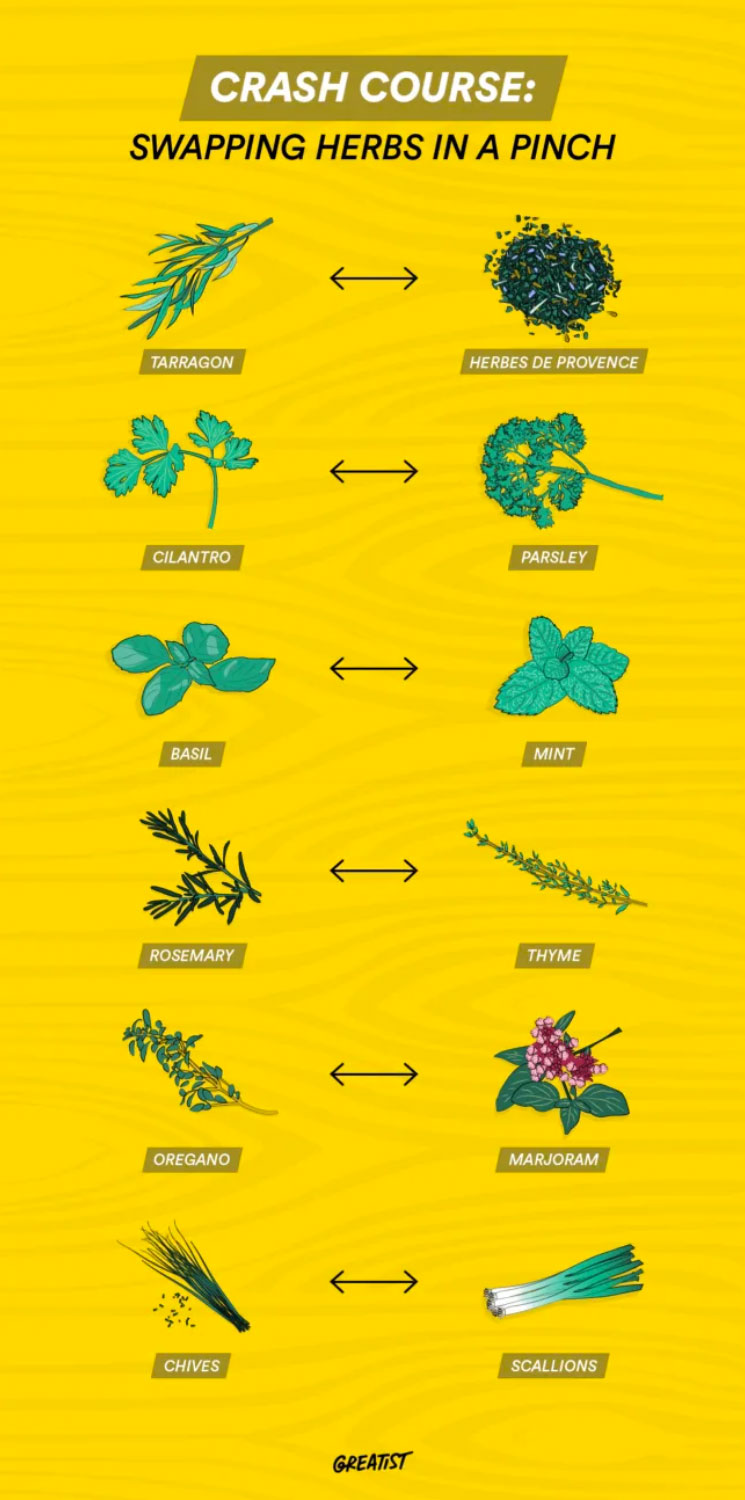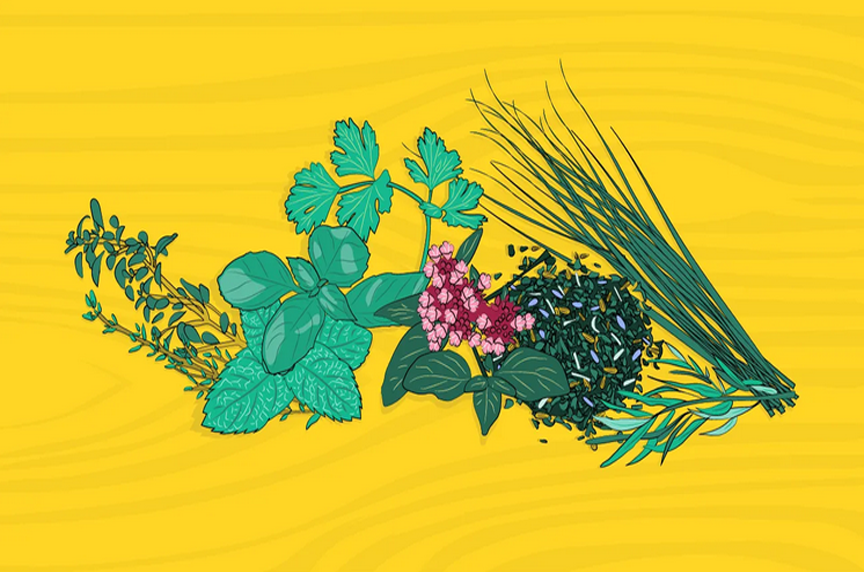Portfolio
Crash Course: Fresh Herbs

Whether you’re a kitchen wiz or a beginner with high hopes, fresh herbs are the ultimate “secret” weapon of cooks at all levels. The fragrance… the color… the taste!
A few minced teaspoons of earthy green goodness can add yum factor and fresh-from-the-garden pizzazz to whatever you’re cooking — from frozen pizza to scrambled eggs to steamy, creamy soups. And when you’re ready to up your game… homemade pesto!
Fresh herbs, in simple terms, are leafy, flavorful, aromatic green plants used in small amounts to flavor and garnish food — rather than to add substance (which sets them apart from veggies).
Herbs are also chock-full of concentrated nutrients and health benefits, like rich vitamins, antioxidants, anti-inflammatories, and natural breath-freshening properties. They’re magical recipe enhancers for so many reasons!
With 75 to 100 different herbs existing in the world, we could all use a crib sheet on how to categorize, choose, cook with, and get the most mileage out of our fresh herbs.
Fresh herbs fall into two main categories: soft herbs (you can cook and eat the stems) and woody herbs (you’ll have to pluck ’em off the inedible stems before you eat ’em). Here are 10 widely used herbs that have made names for themselves as recipe staples:
Soft, leafy herbs
- Basil: Known for its big leaves, distinctly refreshing aroma, and sweet flavor. It’s used around the world to season Italian, Mediterranean, and Asian cuisines — from pasta sauces (like pesto) to caprese salad and Thai stir-fries.
- Parsley: There’s flat-leaf parsley and French curly-leaf parsley, both of which boast a mild, fresh flavor. Fresh parsley is a solid fridge staple because it’s inexpensive and can be added to almost any dish. Try stirring it into tomato sauce, sprinkling it on tilapia, or chopping the flavor-packed stems and adding them to chorizo for extra oomph.
- Cilantro: Cilantro is the Spanish name for coriander (which is the dry seeds of the plant). Its citrusy flavor profile makes it a popular addition to guacamole, salsa, and soups. Cilantro is a polarizing herb, since some people carry a gene that makes it taste like soap.
- Tarragon: Tarragon has skinny leaves that are quite pungent and flavorful (it has a licorice-like taste). French dishes rely heavily on this herb — chicken tarragon, specifically, is delicious and tastes fancy without too much effort.
- Mint: New gardeners, apply here: This highly aromatic herb grows easily and in bounty. Mint has a distinct and invigorating flavor that makes a welcome addition to both sweet and savory dishes and teas.
Woody, hardy herbs
- Rosemary: Rosemary is an evergreen herb that smells and tastes like Christmas. Its robust flavors make it a great addition to roast chicken and even cocktails like winter sangria (as long as you’re too not heavy-handed!).
- Thyme: Another fragrant herb with slight floral notes. Thyme is great for adding to recipes early on because it can handle long cooking times, which also helps mellow out its overpowering flavor. Use it in chicken stock or braised lamb.
- Oregano: Fresh oregano gives you the best of both worlds — its flavors are earthy yet bright, with slight peppery notes (when the leaves also hold their shape well). Chop some up and bake it into fresh dinner rolls, add it to your turkey burger mixture, or sprinkle it over a savory cantaloupe salad with balsamic reduction.
- Chives: A close cousin of scallions and onions, chives have long, green, hollow stems and a not-too-overwhelming oniony flavor. They’re great to add to dips, soups, and potato salad (for both taste and a pretty garnish).
- Sage: Sage has a very strong scent and an earthy flavor that softens when the herb is cooked or even fried. This herb is great for enhancing the flavors in Thanksgiving stuffing, roast pork, and butternut squash.
In an ideal world, you’d always have a stash of fresh herbs on hand to concoct your favorite recipes. But IRL, most of us don’t have a sprawling backyard garden and don’t always remember to grab fresh mint on our supermarket run.
In that case, you may be wondering: Can you replace a fresh herb with its dried version (and vice versa), and how do you do it without ruining dinner?
For starters, dried herbs are much more concentrated and stronger in flavor than fresh herbs. So if you’re swapping fresh for dried, you’ll need to use less. As a general rule, use one-third as much of a dried herb as you would of a fresh herb (e.g., 1 teaspoon dried for every 1 tablespoon fresh) to ensure you don’t accidentally turn your meal into an overly herbaceous blast to the mouth.
In a few cases, substituting won’t give you the same result — with herbs like tarragon and cilantro, the fresh and dried versions have two completely different flavors.
Another loose rule: Dried herbs can stand up to heat better than most fresh herbs, so it’s best to add them while you’re cooking. Fresh herbs should be added later on or as a dish finisher, to help maintain their flavors and textures.
Forgot to buy the tarragon for your recipe, but running back out to the store isn’t on the menu? Luckily, you may already have a perfect substitute on hand with a similar flavor profile.
When swapping herbs, start with less and make sure you like the taste (you can always add more to adjust, but you can’t remove!).

When chopping fresh herbs, less is more — you never want to chop herbs more than once or twice through. Even with a sharp knife, over-butchering soft herbs can lead to ugly brown bruising and cause the leaves to lose their natural oils. With woody herbs, you’ll want to remove the leaves/needles from their stems and then mince ’em in a pile.
Before chopping soft or hardy herbs, ensure they’re washed and completely dry to prevent them from turning to green mush under your knife.
If you’re not growing your own garden (read on for the DIY deets), you’ll want to get the most mileage out of your store-bought fresh herbs. They don’t exactly run cheap, and it’s painful to splurge on the jumbo bunch of dill when all you need is a sprig. We’ve got a few tips to help you waste not, want not.
For starters, properly prepping and storing your herbs will help prevent them from getting wilted, slimy, or moldy while they sit in your fridge.
Whether you snagged a bunch of soft basil or woody rosemary, all fresh herbs like to have a little water on them. As soon as you get home from the store, give them a quick rinse under cold water and a run through a salad spinner — this will help remove rogue debris and germs that can cause mold.
To store soft herbs, start by removing any browned leaves. Fill a glass jar with some water, place the herbs in the jar like a flower bouquet, and then gently cover them with a small plastic bag. Store them in the refrigerator (except for basil, which should be placed uncovered on your counter, near a window to get some sunlight).
To store woody herbs, arrange them on a slightly damp paper towel, loosely roll up the towel, and put it in a plastic bag or plastic wrap. Poke a few holes in the plastic to let the herbs breathe, and then place them in the refrigerator.
If you use proper storing techniques, fresh herbs can last a few weeks. You’ll know it’s time to toss them when the leaves turn dark and/or the stems become brittle.
Another longer-term option: Chop herbs and pop them into an ice cube tray to freeze for later use. You can even freeze them in olive oil for use in sautés or roasted dishes.
Not everyone has easy access to fresh herbs on the regular, especially if you live in a remote area or a food desert. Happily, growing herbs is easy, inexpensive, and something you can do in any size space.
Starter kits are readily available (typically for 30 bucks or less) and generally foolproof.
You definitely don’t need any extra gear to embrace herbs, but for the gadget lovers of the world, here are few inexpensive and handy extras that can make cutting and storing herbs easier:
Now that you’re up on fresh herbs, time to get cookin’… or actually, not cooking. Here are a few of our all-time favorite ways to use herbs that require *zero* stove time:
- Chimichurri: This iconic Mexican sauce gets its vibrant green color from lots and lots of fresh parsley. This version from Muy Delish also uses dried herbs, including oregano and thyme, along with heaps of garlic, olive oil, and other goodies. Use it atop grilled meats and veggies — perfection.
- Caribbean green seasoning: Jamaica-raised food blogger Michelle Blackwood shares the history of green seasoning; how to DIY it using fresh cilantro, thyme, and parsley; and how to use it in curries, soups, and marinades.
- Herb butter: So simple yet so fancy(ish). The key to this flavorful spread is starting with quality butter. From there, add your favorite herb and you’ve got a tasty topping for steaks, shrimp, chicken, or a thick slab of warm, crusty sourdough.
- Herb salt: Three ingredients, tons of uses. Start with pink Himalayan sea salt, and then mix in garlic and fresh herb(s) of your choice. Rosemary, basil, sage, and thyme are all winners. Sprinkle the herb salt on fish, chicken, veggies, and even popcorn.
- Pesto: We’re huge fans of traditional basil-based pesto mixed into everything from pasta to chicken salad, but we also love unique spins like this sage-and-walnut combo.
Portfolio> Home>
Client: Greatist
Date: July 13, 2020
Service: Copywriter
